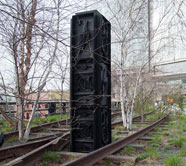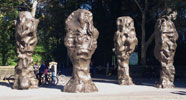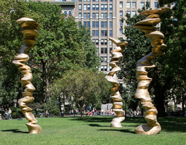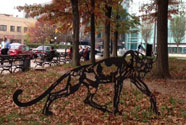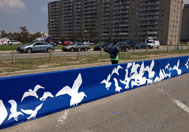Art in the Parks
Through collaborations with a diverse group of arts organizations and artists, Parks brings to the public both experimental and traditional art in many park locations. Please browse our list of current exhibits and our archives of past exhibits below. You can also see past grant opportunities or read more about the Art in the Parks Program.
Public Art Map and Guide
Find out which current exhibits are on display near you, and browse our permanent monument collection.
Search Current and Past Exhibits
2015
Manhattan
Various Artists, Archeo
April 17, 2014 to March, 2015
The High Line, Manhattan
Map/Directions (in Google Maps)
Please note: This is a past exhibit that is no longer installed in the park.
An outdoor group exhibition about technology and obsolescence, Archeo brings together the work of artists who employ outmoded technologies and outdated machinery as a reflection on humanity’s continuous fascination and frustration with technology.
Today, many young artists engage with technology by exposing both its fragilities and merits. Their artworks embody an attitude that is simultaneously critical and nostalgic, in which the optimistic idealism of technological progress is countered by a disenchanted skepticism. Some of the works in the exhibition describe a recent past which resembles a dystopian future, featuring a wasteland of discarded machines and castaway objects. Other artists are more enthusiastic about the potential of technology but warn us against its dangerous side effects and its planned obsolescence. Some of the artworks on view disclose a return to the handmade and an attraction to organic forms and materials. These sculptures resemble relics and findings of an archaeology of the future.
Archeo features international artists including: Antoine Catala, Isabelle Cornaro, Jessica Jackson Hutchins, Yngve Holen, Gavin Kenyon, Josh Kline, Marianne Vitale
This exhibition is presented by the Friends of the High Line.
![]()
Stereotank, HeartBeat
February 9, 2015 to March 8, 2015
Father Duffy Square, Manhattan
Please note: This is a past exhibit that is no longer installed in the park.
This sculpture consists of a massive heart glowing to the rhythm of a strong, deep and low frequency heartbeat sound which changes its rate as visitors approach, move around and engage with it by playing various percussion instruments and joining the base rhythm of the heartbeat. The audience is invited to come together and creatively play, listen, dance and feel the vibrations of the heart while enjoying the warm pulsating light.
Brooklyn-based design studio Stereotank’s design was selected for the 2015 Times Square Valentine Heart. Times Square Alliance partnered with The Architectural League of New York and invited architecture and design firms to submit proposals for a public art installation celebrating Valentine’s Day in Times Square.
This exhibition is presented by the Times Square Alliance and The Architectural League of New York.
![]()
Sui Jianguo, Blind Portraits
October 28, 2014 to February 20, 2015
Doris C. Freedman Plaza
Central Park, Manhattan
Map/Directions (in Google Maps)
Please note: This is a past exhibit that is no longer installed in the park.
These monumental cast bronzes are not portraits in the traditional sense. All of them have features that resemble faces, but none depict specific people. This is not surprising given that they were enlarged from small clay models created by Sui Jianguo while blindfolded. The “portraits” are the intuitive results of the artist manipulating his material without the benefit of sight.
For Sui, this apparent limitation is a means of finding a different – and equally valid – method of creating sculpture. In this way, the artist brings together traditions of Chinese aesthetics and Western modernism, both of which share an interest in exploring the essential nature of materials and the effects of chance.
This exhibition is presented by the Public Art Fund
![]()
Tony Cragg, Walks of Life
September 18, 2014 to February 8, 2015
Madison Square Park, Manhattan
Map/Directions (in Google Maps)
Please note: This is a past exhibit that is no longer installed in the park.
Tony Cragg’s Walks of Life consists of three monumental bronze sculptures on three lawns in the Park. His work supplants any longstanding art historical division between abstraction and figuration: his sculptural innovation is to fuse both styles in one work and to make bronze into a malleable material. Cragg’s sculpture is characterized by repeated facial profiles and torqueing imagery that reshapes the experienced world. These forms intermingle to create vital objects where contours shift and morph, provoking the viewer to differentiate between a work of humanism and a work of dynamism.
Installed on the west gravel section of the Park, Cragg’s Caldera is a strapping, tumultuous sculpture that rests on three points. Viewers will have the opportunity to walk beneath the work to experience its massive presence. At eighteen feet high, Mixed Feelings will command a northern lawn. Three times human height, the object is simultaneously immense and elegant. Points of View is a tripartite work of sinuous forms which interact with one another and with the viewer on the Park’s Oval Lawn. Facial profiles zig and zag across each column’s surface. All three sculptures in this exhibition were cast specifically for Madison Square Park.
This exhibition is presented by Mad.Sq.Art
![]()
Queens
Wendy Klemperer, Shadow Migration
November 7, 2015 to November 7, 2016
Court Square Park, Queens
Map/Directions (in Google Maps)
Please note: This is a past exhibit that is no longer installed in the park.
Shadow Migration exhibits animal silhouettes cut from steel plates and installed throughout the park. Klemperer investigates animal populations that were threatened in the 20th century, but are now rebounding and showing up in “our backyard.” Wild animals are finding their way into suburban and urban environments as human populations sprawl into their natural habitats. While many species have been devastated, some are adapting and thriving on the largesse of urban life. Hawks dive from high rise cornices to feast on the rich urban population of pigeons and rats; bears walk through New Jersey neighborhoods; and just several blocks from Court Square Park, a coyote found its way to a rooftop in Long Island City.
Klemperer’s animal silhouettes are steel forms, punctuated with cutouts in the shape of countries from around the world. Each animal is a melting pot, bearing countries on its body that are also represented in Queens’ population—the most diverse community in the world.
This exhibition was made possible by the Clare Weiss Emerging Artist Award.
![]()
Patty Harris, Ride the Wave
July 2013 to June 2016
Shorefront Parkway, Between Beach 74 Street and Beach 107 Street, Queens
Map/Directions (in Google Maps)
Please note: This is a past exhibit that is no longer installed in the park.
The Rockaway Barrier Beautification Project is the longest mural in New York City, covering a 1.5 mile stretch of road along the beach in Rockaway, Queens. NYC Parks invited artists and designers to envision the surface of these ordinary barriers as canvases for art. Members of the community helped to select the top three designs that grace the surface of these barriers and paint the murals.
This project was made possible thanks to a partnership between NYC Parks and the NYC Department of Transportation, the Community Affairs Unit (CAU) of the Office of the Mayor, NYC Service, and community groups, including the Rockaway Beach Civic Association, Rockaway Artists Alliance, and Friends of Rockaway Beach. Benjamin Moore generously donated 420 gallons of paint to the Mayor’s Fund to Advance New York City for this initiative.
As an artist, Patty Harris has created animations of floods and is fascinated by the way water moves. Experienced in looking closely at the sea, she pulled a few simple forms that suggest the movement and pattern of a wave. For the Shore Parkway barrier, Patty painted shapes that express the undulating movement of a wave. She added curved shapes that hold water of a slightly different color—just as actual water displays a range of hues. To this rhythmical simple pattern, Harris included the silhouetted forms of surfers at the crests of the waves.
Learn more about the Rockaway Barrier Beautification Project.
![]()
John Garcia, Untitled
July 2013 to June 2016
Shorefront Parkway, Between Beach 74 Street and Beach 107 Street, Queens
Map/Directions (in Google Maps)
Please note: This is a past exhibit that is no longer installed in the park.
The Rockaway Barrier Beautification Project is the longest mural in New York City, covering a 1.5 mile stretch of road along the beach in Rockaway, Queens. NYC Parks invited artists and designers to envision the surface of these ordinary barriers as canvases for art. Members of the community helped to select the top three designs that grace the surface of these barriers and paint the murals.
This project was made possible thanks to a partnership between NYC Parks and the NYC Department of Transportation, the Community Affairs Unit (CAU) of the Office of the Mayor, NYC Service, and community groups, including the Rockaway Beach Civic Association, Rockaway Artists Alliance, and Friends of Rockaway Beach. Benjamin Moore generously donated 420 gallons of paint to the MayorâΑΑs Fund to Advance New York City for this initiative.
As a surf regular of Rockaway Beach, John Garcia pays tribute to Rockaway BeachâΑΑs surf culture in his barrier mural. He has painted images of Rockaway surfers riding waves, along with the birds that often keep them company on the water and on the shore. These images of birds and surfers sit on top of an aquatic abstract backdrop that captures the mystery and beauty of the ocean. The barriers also include the text âΑΑWelcome to the RockawaysâΑÂÂ as an invitation for others to experience the waves and serenity of Rockaway Beach.
Learn more about the Rockaway Barrier Beautification Project.
![]()
Jade Chan, In Flight
July 2013 to June 2016
Shorefront Parkway between Beach 77 Street and Beach 107 Street, Queens
Map/Directions (in Google Maps)
Please note: This is a past exhibit that is no longer installed in the park.
The Rockaway Barrier Beautification Project is the longest mural in New York City, covering a 1.5 mile stretch of road along the beach in Rockaway, Queens. NYC Parks invited artists and designers to envision the surface of these ordinary barriers as canvases for art. Members of the community helped to select the top three designs that grace the surface of these barriers and paint the murals.
This project was made possible thanks to a partnership between NYC Parks and the NYC Department of Transportation, the Community Affairs Unit (CAU) of the Office of the Mayor, NYC Service, and community groups, including the Rockaway Beach Civic Association, Rockaway Artists Alliance, and Friends of Rockaway Beach. Benjamin Moore generously donated 420 gallons of paint to the MayorâΑΑs Fund to Advance New York City for this initiative.
Jade Chan's design for the Rockaway barriers is titled In Flight. When she visited Rockaway Beach, she was inspired by the warmth, the sun and the colors that jumped out at her from the sky, water and sand. The sound of the surf and the breeze upon her skin was exhilarating. She observed the birds in flight and was inspired by this free and liberating vision. Chan sees In Flight as a representation of the freedom and strength of the human spirit.
Learn more about the Rockaway Barrier Beautification Project.
![]()
Fanny Allie, A Bench for the Night
May 18, 2015 to May 1, 2016
PS1 Greenstreet (Jackson Avenue and 46th Avenue), Queens, Queens
Map/Directions (in Google Maps)
Please note: This is a past exhibit that is no longer installed in the park.
Artist Fanny Allié raises awareness about homelessness in her public art installation A Bench for the Night. Her wooden bench is shaped in the silhouette of a sleeping person, a reminder that a public bench is a potential bed for some New Yorkers. She is interested in personifying the bench while subtly referring to the dehumanization of people living on the streets.
A Bench for the Night is a continuation of Allié’s focus on this important social issue. In 2014 she took part in the Engaging Artists Residency organized by the Artist Volunteer Center and More Art, which primarily focused on homelessness. Engaging Artists encourages local artists to deepen their understanding of socially engaged art through volunteer opportunities and interactive workshops with professionals in the fields of fine art and activism. During this six–week program, participants were required to volunteer at least a half a day per week at a local charitable organization.
In 2013, Allié also exhibited the public artwork Serendipity in Tompkins Square Park. The sculpture was a life–size, steel silhouette of a formerly homeless man who spent much of his time in the park. Furthermore, A Bench for the Night is the continuation of her earlier neon sculpture The Glowing Homeless created in 2011 for Bring to Light: Nuit Blanche New York in Greenpoint, Brooklyn. The Glowing Homeless was a neon outline of a human form that rested on a park bench. By rendering the homeless person in neon light asleep amongst the park’s crowds she created an alluring object using an attractive material that reversed the normal reaction of avoidance and instead drew people towards the form on the bench. Allié’s new A Bench For the Night will invite the audience to sit on the bench, an interaction between the public and the artwork that was not possible with The Glowing Homeless.
While A Bench For a Night primarily alludes to homelessness, the piece also reflects one’s desire to seek an isolated place to rest and remove oneself from the continuous movement of the city. When preparing for this exhibit, Allié noticed a lack of seating in the immediate vicinity. By placing the bench–sculpture in this small plaza, she has created a new social space that simultaneously raises awareness on homelessness among the general public, as well as artists and art–lovers visiting MoMA PS1 located across the street.
![]()
Duke Riley, El Primero Desfile de San Patricio en la Habana, Cuba
September 27, 2015 to March 13, 2016
Socrates Sculpture Park, Queens
Map/Directions (in Google Maps)
Please note: This is a past exhibit that is no longer installed in the park.
Socrates’ latest “Broadway Billboard” is by artist Duke Riley and is titled El Primero Desfile de San Patricio en la Habana, Cuba, or, The First St. Patrick’s Day Parade in Havana, Cuba.
St. Patrick’s Day marks the celebration of the life of the patron saint of Ireland and is observed by people of Irish descent around the world. But, as Riley states, “the tradition of the St. Patrick’s Day Parade is entirely American.” The first parade in honor of St. Patrick’s Day was organized by Irishmen serving in the British army stationed in Boston, Massachusetts in 1737. It began as nothing more than drunken revelry, singing, and a shared sense of homesickness. 200 years later the tradition was adopted in Ireland and today there are St. Patrick’s Day parades in 15 nations across six continents.
During a 2007 visit to Havana, Riley discovered that his Irish roots had Cuban connections. In fact, one of of the city’s main streets is called Calle O’Reilly, named for Alejandro O’Reilly, an Irishman and early abolitionist who served as a general in the Spanish army in 18th–century Cuba and later served as governor of Spanish–occupied Louisiana. Like O’Reilly, many Irish settled in Cuba in the 18th and 19th centuries, leaving a legacy of prominent historical figures of Irish–Cuban descent and there are still a great number of current day Cuban residents with Irish heritage.
With this history in mind, Duke Riley returned to Cuba in 2009 to stage the first St. Patrick’s Day Parade in Havana, a performance for ‘Chelsea Visits Havana’ at Museum Nacional de Bellas Artes as part of the Havana Biennial. The Broadway Billboard on view at Socrates Sculpture Park consists of a section of a larger drawing the artist did as a record of his 2009 performance, along with representations of iconic American cartoon characters marching through the streets of Havana.
Like the first parades in America, Riley’s St. Patrick’s Day performance reminded participants of the positive potentials of social inclusion and cultural exchange from the earliest parades and commemorations. Riley’s 2009 parade displayed a romanticized vision of a distant land – Ireland, Cuba, and America – separated by the sea. With today’s warming of relations between historically cool American and Cuban governments, El Primero Desfile de San Patricio en la Habana, Cuba presciently experiments with the merging of the two cultures.
This exhibition is presented by Socrates Sculpture Park
![]()
